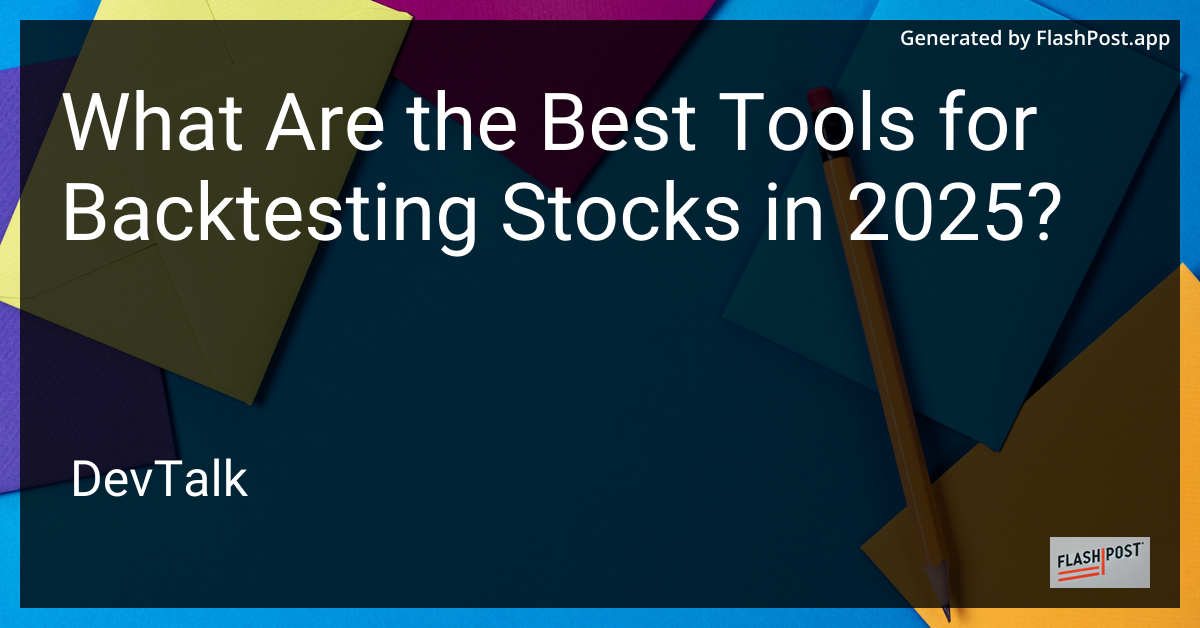What Are the Best Tools for Backtesting Stocks in 2025?
 # Best Tools for Backtesting Stocks in 2025
# Best Tools for Backtesting Stocks in 2025
Backtesting is an essential part of developing a reliable trading strategy, as it allows investors to test their hypotheses with historical data before risking real money.
As we approach 2025, the tools available for backtesting stocks have become more advanced and user-friendly. In this article, we'll explore the best tools for backtesting stocks in 2025 and how they can help improve your trading strategies.
Why Backtesting is Important
Backtesting involves testing a trading strategy on historical data to analyze its performance. The key benefits of backtesting include:
- Strategy Validation: Confirms whether a trading strategy is viable.
- Risk Management: Helps in identifying potential risks and returns.
- Optimization: Assists in fine-tuning strategy parameters for better performance.
Read more about backtesting techniques to handle market volatility in this comprehensive guide.
Top Backtesting Tools of 2025
1. TradingView
TradingView continues to be a popular platform among traders due to its powerful charting tools and comprehensive data coverage. It offers a robust backtesting engine, Pine Script language, which allows users to write and test custom strategies effortlessly.
- Key Features:
- User-friendly interface.
- Extensive library of indicators and strategies.
- Real-time scanning and alerts.
2. QuantConnect
QuantConnect is a versatile platform known for its open-source algorithmic trading framework, Lean. It allows traders to design and test strategies using multiple data sources and supports several asset classes including stocks, forex, futures, and cryptocurrencies.
- Key Features:
- Supports C#, Python, and F# languages.
- Access to a community of developers for support and collaboration.
- Cloud-based platform allowing seamless backtesting without hardware constraints.
3. MetaTrader 5
MetaTrader 5 (MT5) remains a staple for forex and stock traders in 2025. It provides an integrated Strategy Tester, which allows for multi-threaded backtesting and optimization using its powerful MQL5 programming language.
- Key Features:
- Multi-currency backtesting.
- Agent network for distributing optimization tasks.
- Comprehensive reports for strategy evaluation.
4. Amibroker
Amibroker is renowned for its flexibility and speed in backtesting large data sets. Its advanced AFL (Amibroker Formula Language) allows for custom script development to craft unique trading strategies.
- Key Features:
- Ultra-fast backtesting engine.
- Interactive data visualization tools.
- Plug-in support for third-party data feeds.
Dive deeper into how to use software for backtesting stock strategies here.
5. MultiCharts
MultiCharts is celebrated for its strength in handling complex backtesting scenarios, especially for futures and stocks. Its robust portfolio backtester can simulate multiple strategies across different assets simultaneously.
- Key Features:
- Advanced charting capabilities.
- Easy integration with brokers for live trading.
- Comprehensive strategy development tools.
How to Choose the Right Backtesting Tool
When selecting a tool for backtesting stocks, consider the following factors:
- Programming Language: Ensure the tool supports a language you are comfortable with.
- Data Availability: Check if the tool provides access to the historical data you need.
- Cost: Consider your budget, as some platforms offer advanced features at higher prices.
- Community Support: A vibrant community can provide valuable resources and assistance.
For a detailed process on how to backtest trading strategies for accuracy, explore this helpful article.
Conclusion
With the right backtesting tool, you can efficiently analyze your trading strategies and optimize them for better performance in real-world markets. As technology advances, platforms like TradingView, QuantConnect, MT5, Amibroker, and MultiCharts provide powerful features that meet the diverse needs of modern traders. Always remember to thoroughly test your strategies before live trading to mitigate risks and enhance profitability.